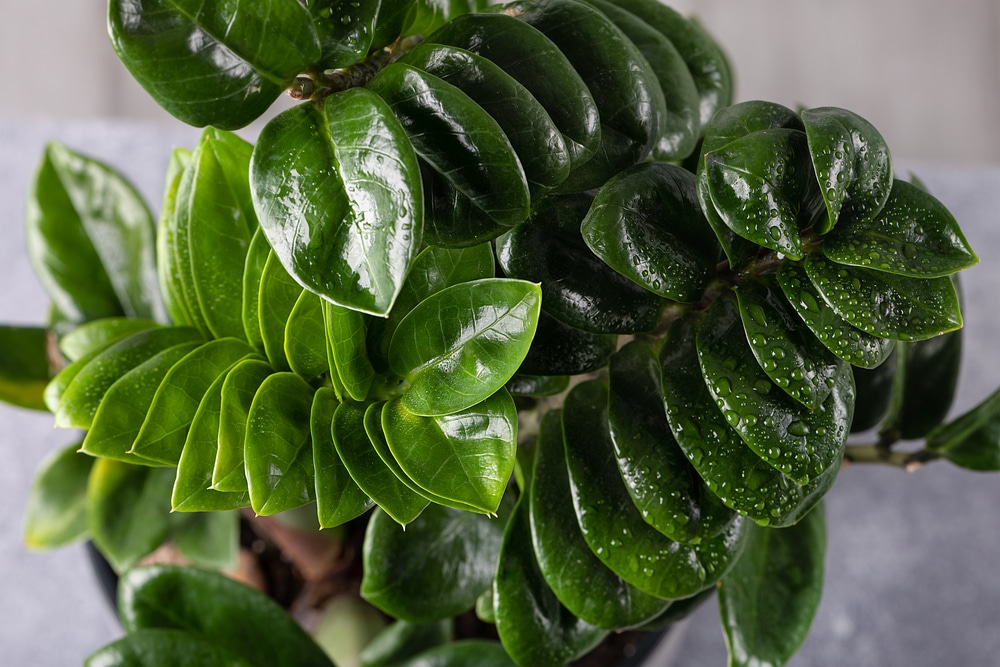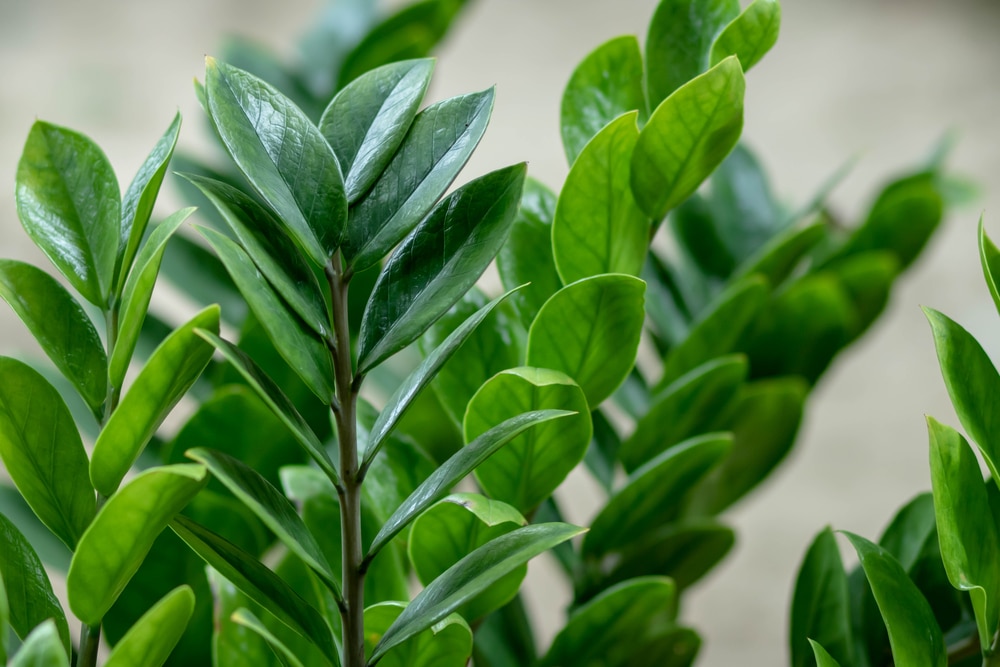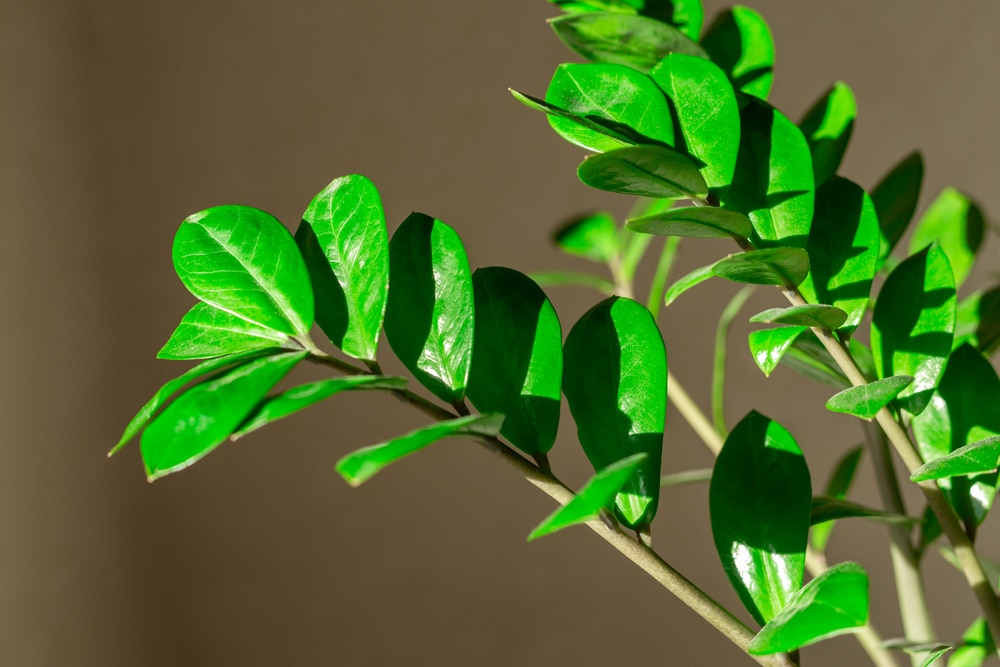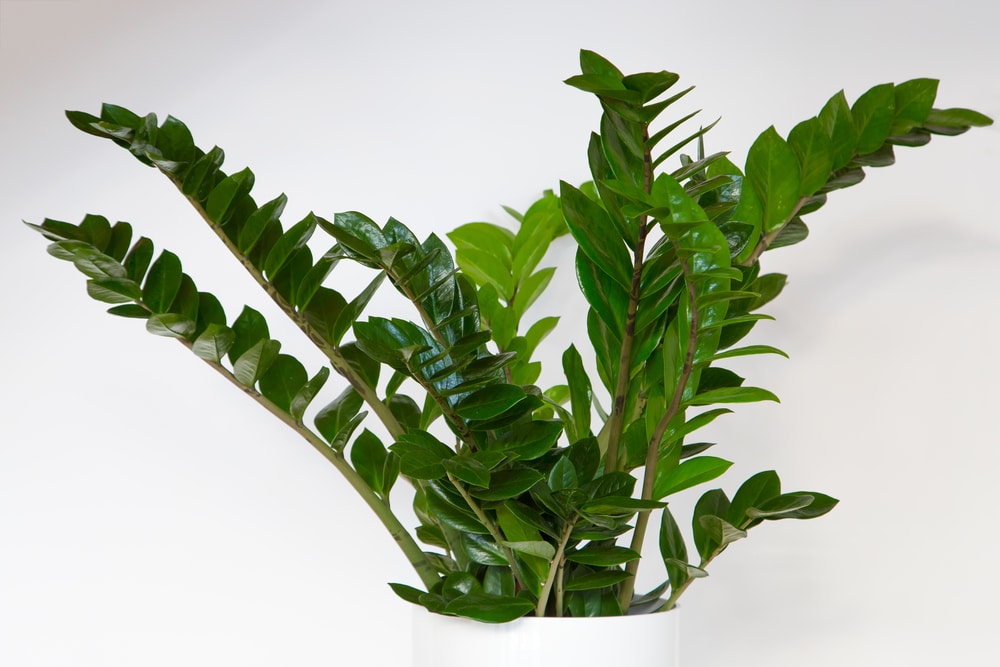Zamioculcas zamiifolia is a hugely popular plant that made its way into almost everyone’s homes when it began trending once again in the 2010s. Also affectionately known as ZZ plant, this species is beloved for its signature teardrop leaves and deep green foliage. Aside from its aesthetic beauty, ZZ plants are notoriously easy to care for, which is what makes them such a great plant for beginners and experienced plant lovers alike. Read on to find out exactly what ZZ plants like, and how to keep one happy for years to come!
Origin and History of Zamioculcas Zamiifolia
In the early 1800s, this plant was actually considered to be a Caladium, which is far from what we now know about it today. The plant was documented in South Africa by many traveling botanists from the 19th century until the 1990s, when it was finally collected by Dutch explorers, who brought it back to the Netherlands for study and, eventually, mass propagation. While many of today’s popular houseplants originated in Africa, they’ve been bred over countless generations to tolerate the average conditions of a North American home. Our beloved ZZ plant, while a native African descendant itself, has taken this path as well.

ZZ Plant Care
Like most African plants, ZZ plants are fairly easy to care for and grow indoors. They require roughly the same standards as most indoor houseplants, which makes it super easy to incorporate them into your existing plant collection. While you likely already have an idea of how to take care of a plant like Zamioculcas zamiifolia, we’ll run through the basics just in case you’d like a few great tips and tricks for caring for your ZZ plant!
Growth Habits
ZZ plants are best known for their growth patterns. While they’re a flowering plant, it’s rare to see any blooms; the deep, emerald green foliage and chocolate brown stems do most of the heavy lifting. That being said, everything is perched atop a bulb under the soil that can grow one or more stems before dividing into more bulbs. Being a tuber isn’t all that bad, though, because ZZ plants are also easy to divide and repot for this reason; but more on that later. For now, we’ll start with the ZZ plant being a tuber and growing individual stems that each carry a multitude of pairs of leaves. Think decorative leaf patterns around a monogram: ZZ plant leaves look just like them. After a few years, one bulb can divide into a handful, which continue to divide exponentially after that. Long story short, ZZ plants are easy to propagate.
Light Requirements
ZZ plants need a lot of light, and by a lot of light, we mean they need around 10 hours of bright, indirect sunlight each day for optimal growth and photosynthesis. Of course, in a house or office environment, these hours will be cut short; nevertheless, a ZZ plant will happily thrive near bright, full-spectrum LED bulbs. Try to provide bright light without allowing the sun’s rays to actually hit the foliage; this can cause sunburn or “sun spots”, which are spots that appear to turn brown and then very thin. Signs of these marks are a sign that you should move your ZZ plant a bit further away from its window, or perhaps add a sheer curtain to help diffuse some of those harsh UV rays the news is always talking about.
Water Schedule
Try to water your ZZ plant only when the top inch of soil in its pot is dry. Watering too often can cause root rot or cause bulbs to begin to deteriorate. On the other hand, watering too little will take the obvious turn: wilting, colorless leaves, limp stems, and the ever-so-familiar wrinkles of the plant you forgot about when you went on that vacation a few years back. If you have trouble remembering to water, try installing a moisture meter to help you notice when the soil is getting a little dry for a ZZ plant’s taste. You can also try a watering bulb, which is filled with water and then buried in the soil near where the roots are growing. Keeping your ZZ plant watered and happy is the best way to watch it grow quicker and healthier.
Temperature and Humidity
Part of what makes ZZ plants so appealing is that they prefer the same temperature zones as we do; anywhere from 60 to 75 degrees fahrenheit is great, but they’ll tolerate a little push in either direction to an extent. ZZ plants won’t do well in temperatures under 40 degrees or over 90 degrees fahrenheit, so try not to leave them too close to an open window or near a heater (which dries them out, too). As far as humidity goes, ZZ plants definitely like at least some humidity. If you have drier air in your house, which is normally due to central air, you can either use a humidifier nearby or place a tray of wet pebbles underneath the plant, which will evaporate into some nice, refreshing moisture for your ZZ plant.

Soil and Potting
ZZ plants, like many other common houseplants, do best in a soil mix that includes peat, coco, and perlite or vermiculite. These types of soils imitate the rich humus that can be found in the most fertile places on Earth for plants to grow, and is therefore used for almost everything from vines and cacti to flowers and shrubs. While you can easily find soil like this premixed at any big box store, don’t be afraid to keep the components around so that you can tailor your own soil to your plants’ individual needs. With potting a ZZ plant, you should un-pot and divide your ZZ plant every spring (make sure there aren’t too many bulbs in one pot), then repot them in completely fresh soil so that they have plenty of nutrients until next year. Always allow room for bulbs to form; there should be around two inches of space between the outside bulb and the inside of the pot.
Fertilizing
During the colder months, it’s best to stick to fertilizing your ZZ plant only once every six months. However, when the weather begins to warm up and the planting season is just beginning, begin fertilizing every three months for the best growth throughout the growing season. Once mid-summer has passed, you can lighten up again, moving back to the six-month regimen. If you don’t always remember to fertilize, that’s perfectly fine; the annual repotting should give your ZZ plant enough nutrients to survive on its own without extra food, but giving it that blast of nutrients just before the growing season yields the best results if a large plant is what you’re after. Any fixed-ratio houseplant fertilizer will do, so long as it contains nitrogen, phosphorus, and potash. These are easy to find at most big box stores and plant nurseries.
Pruning
While ZZ plants don’t necessarily need to be pruned as often as others in your collection may, it can sometimes be beneficial to the plant or to you to do a light trim once every so often. If you start to notice that your stems are looking leggy, you can snip away those parts down to the bottom leaf or even below the soil surface. Never prune ZZ plants without gloves, however, as they do contain a mild irritant that can be uncomfortable to get on your skin or in your eyes. Pruning may also be in order if your plant develops a pest or disease infection, which can help to minimize the damage done by said annoyances. Last but not least, you can always trim a little if your ZZ plant is looking a little lopsided, or if some stems begin to stick out far more than the others.
Toxicity
You may have noticed the brief mention of this plant’s toxicity regarding the mild irritant wrapped up in each little bit of a ZZ plant. While this sounds worse than it is, it’s generally a good idea to keep plants up and away from the reach of pets and children, especially those with allergies and other pre-existing conditions. On another note, as long as you wear gloves and eye protection if you feel the need, you should be just fine. Make sure that you dispose of any trimmings from your ZZ plant in a location inaccessible to the aforementioned parties, as it’s easy to forget to pick up that one leaf you missed while sweeping!

Common Pests & Diseases
These two common problems are introduced in a variety of ways. Occasionally, plants can catch and spread disease (such as viruses, fungal spores, and bacteria) between each other in plant shops, stores, and nursery trucks. Don’t worry, most plant infections are nowhere near contagious to people; however, they certainly are transmissible from plant to plant. One of the most common offenders is the ever-irritating mealybug. Mealybugs, such as scale, can affect a ZZ plant straight away; they nest under the leaves and burrow into the stems of plants, which depletes the plants of much-needed nutrients for survival. Other common pests, such as spider mites or soil gnats, can be eradicated more easily using chemical pesticides and natural methods. It’s unlikely that your ZZ plant will come down with a fungal or bacterial infection in its lifetime, but it isn’t impossible. Watch for signs of yellowing and slowed growth, both of which are signs that your ZZ plant isn’t doing great.
Frequently Asked Questions
If after reading all sorts of information online about ZZ plants you still have a few questions, fear not; other people are likely wondering the same things that you are. For that reason, we’ve put together a list of the most frequently asked questions about Zamioculcas zamiifolia to help enlighten you about questions you may still have about the ZZ plant.
Why is my ZZ plant not growing?
A: The answer can actually be attributed to a number of factors. First and foremost is light. If your ZZ plant seems to be dark and growing especially slowly, it likely needs a bit more light. Foliage should be medium to light green, depending on the season. Of course, ZZ plants are slow-growing, so if it’s been about a year since you’ve seen any new growth, it may just be that the growing season is about to begin. If still no growth is happening by Spring, you should try repotting or fertilizing your ZZ plant. It may just be out of room to grow or nutrients to grow with! Another common reason for the slowed growth of a ZZ plant is an infection. These are most likely to be an infestation of pests, whether they be microscopic or easy to spot from a different angle. If you notice any odd webbing or clusters near where the leaves meet the stems, it’s likely pests. Try using a chemical fertilizer or other more natural method to eliminate them before the pests spread to any nearby plants.
How many bulbs should be potted together?
A: Technically, you can leave a ZZ plant bulb cluster together to keep growing and growing as long as you want, so long as you continue to repot and give it more room to grow each year. Otherwise, there’s no magic number on how many should be planted in a pot. ZZ plants can look adorable with just one bulb and stem in a small pot, or they can be portrayed as tropical, majestic floor plants in a large planter with lush foliage. No matter how many bulbs you keep in each pot, remember that they all need enough room to grow and divide, so always account for another bulb’s worth of extra space for each bulb that goes into a pot. Their roots tend to grow down more than out to the sides, so deeper pots for larger clusters helps them out quite a lot. You should, however, avoid planting bulbs on top of one another. The two will compete for light, water and nutrients, which puts unnecessary stress on each of them.
What types of plants can be planted with a ZZ plant?
A: Plants that are mixed together in potted arrangements must do one thing before all else: coexist. If plants are potted together that don’t benefit one another, there will be issues. Since ZZ plants are bulbous tubers, try to avoid planting other tubers in with them. Instead, great options might include vines (that grow away from the ZZ plant), grasses, or flowering plants. Plants that grow and divide quickly, or that might overgrow a ZZ plant, should be avoided, as they will definitely outlive your ZZ plant. Since ZZ plants grow so slowly, you might consider options for other plants that grow slowly as well, such as croton, african violets, and even well-trained pothos. If you do plant one with a vining plant, be sure to train the vine away so that it doesn’t begin to climb the stems of your ZZ plants. In such a small habitat, plants don’t want to compete with each other!

